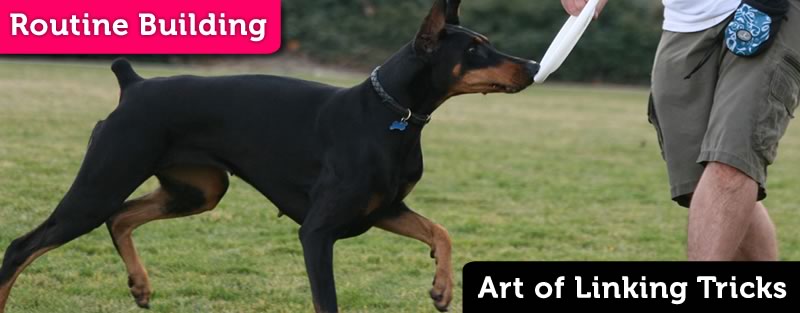
Art of Linking Tricks
Starting to create sequences can be a very frustrating endeavor for both dog and handler. It’s very common to see new players struggle through simple sequences doing damage to their established tricks and to their relationships with their dogs. There are a few simple rules to follow to help make creating sequences a smooth and successful process.
Start With a Strong Foundation
A disc dog foundation should be laid with treats. Each component skill must be taught and understood by both dog and handler before we go out and try to use them as part of a sequence. Sequences are nothing more than behavior chains, and a sequence is only as strong as the weakest link in that chain. Each behavior in the chain must be strong. if a link in the chain, a component element of the sequence, is not solid, the sequence will break down right there at that point. Especially if we add stress. If the sequence breaks down at the same place and time, we should be sure to put some additional emphasis on that weak link outside of working the sequence. Repetitive failure is habit forming. It’s much better to take a couple steps back and isolate, then strengthen, a weak link than it is to try to push our dogs through right through it.
Set clear and attainable Criteria
We need to have a good plan that can succeed and stick to it. It’s very important that our dogs know what behaviors are being asked for and that they have the ability to perform the behaviors that are being asked. Shifting gears with our dog while creating complex behavior chains is a recipe for failure. That being said, we, as Disc Dog handlers, must be on the lookout for mistakes that are cool. We must be observant enough to notice when a mistake is cool and be flexible enough to take advantage of situations that present themselves that could create a special trick or sequence. We must also be aware of the need to switch gears to keep the flow of the lesson going, to keep the energy level of the game up. If we have a dog that is starting to get confused or is otherwise struggling it is a good idea to go back to an easier or high value behavior to get some success and to funnel that success into the behavior chain at hand. Let’s play a game: what’s 2×2? what’s 3×3? 4×4? 8×8? … 365×458? Do you want to play any more? OK let’s try again… 954×356? We turn off to games that are too hard, and so do our dogs. Setting attainable criteria is a must.
Ease Into It
When teaching a new sequence to our dogs, one that will challenge them, we want to make sure that we ease into it. Walking out onto the field and working on a troubled or difficult sequence while our dogs are totally cold and chomping at the bit to play is probably not going to be successful. We need to warm them up. We need to give them a gimmee or two. Perhaps we work a sequence that is similar, or fall back on the progression that we used to teach the sequence with treats. Success builds upon itself. The more successful we are the more apt our dogs will be to have the confidence to handle greater challenges. When we work on difficult sequences most of our time should be spent keeping our dog’s energy level and success rate high. It’s simply rate of reinforcement, really. We do fun things that are easy. We get the dog engaged. We get them fired up. Then we ask them to try something a bit more challenging while they’re flying high and having fun. When we try something that we know will challenge our dogs it’s a good idea to spend at least 3 or 4 times as much time building them up for the challenge as actually working the challenge itself.
Trick…Wait…Trick
This one probably should have been first, but if it were first nobody would read any more. We’d all be out working with our dogs. Breaking the behavior chain down into it’s component links and rewarding each one will improve the clarity of the task at hand. The criteria will be clear and our dogs will understand what’s being asked. Our dogs will be successful. Let’s say we want to teach Through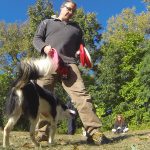 A Through is a set up move where the dog runs between the handler’s legs. The dog can move from front to back or side to side and can even weave. A Through... More (handler wheels to face dog)…Flip…Spin…Leg Vault
A Through is a set up move where the dog runs between the handler’s legs. The dog can move from front to back or side to side and can even weave. A Through... More (handler wheels to face dog)…Flip…Spin…Leg Vault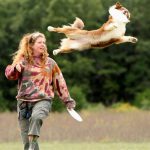 The dog uses the player´s body as a launching pad to jump for a disc. A Vault is a leaping catch from the handler’s body. The dog leaves the ground for the target... More: We ask the dog through and the handler wheels to face the dog. Give
The dog uses the player´s body as a launching pad to jump for a disc. A Vault is a leaping catch from the handler’s body. The dog leaves the ground for the target... More: We ask the dog through and the handler wheels to face the dog. Give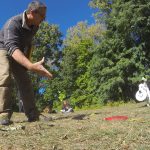 The Give is a retrieve to the hand. A cued Give is a foundational skill that is not super useful in the actual performance of disc dog freestyle, and has huge applications for... More a wait command. Hold a second. Then we toss the flip and give the cue to wait. Give the spin
The Give is a retrieve to the hand. A cued Give is a foundational skill that is not super useful in the actual performance of disc dog freestyle, and has huge applications for... More a wait command. Hold a second. Then we toss the flip and give the cue to wait. Give the spin Spins and Twists are tricks where the dog spins 360 degrees in a clockwise or counter clockwise fashion. Spin is clockwise and Twist is counter clockwise so it is important to have a... More cue then the wait cue. Hold a sec. Leg Vault. Long toss for a reward, a little praise party, then we do it again. After several run throughs of this sequence broken up by waits, we should have a dog that totally understands what’s coming. Now
Spins and Twists are tricks where the dog spins 360 degrees in a clockwise or counter clockwise fashion. Spin is clockwise and Twist is counter clockwise so it is important to have a... More cue then the wait cue. Hold a sec. Leg Vault. Long toss for a reward, a little praise party, then we do it again. After several run throughs of this sequence broken up by waits, we should have a dog that totally understands what’s coming. Now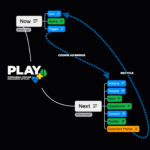 The Now Phase is an integral part of the Play Cycle in the Play+ training philosophy. It embodies the current, immediate interaction between the handler and the dog, anchoring them in the present... More we can let it rip and our dog is will know what’s coming next. Not only will they know what’s coming next, but they will be happy to be free to move freely instead of having to do that darn wait! If any of the components starts to break down, work the sequence and place value immediately upon the completion of the challenging behavior with a bite or some other reward. This is an extremely important technical concept, not only for success but for safety. If we do this right, our dogs totally understand what’s coming and we, as handlers, have the ability to deliver well placed discs and to be well positioned.
The Now Phase is an integral part of the Play Cycle in the Play+ training philosophy. It embodies the current, immediate interaction between the handler and the dog, anchoring them in the present... More we can let it rip and our dog is will know what’s coming next. Not only will they know what’s coming next, but they will be happy to be free to move freely instead of having to do that darn wait! If any of the components starts to break down, work the sequence and place value immediately upon the completion of the challenging behavior with a bite or some other reward. This is an extremely important technical concept, not only for success but for safety. If we do this right, our dogs totally understand what’s coming and we, as handlers, have the ability to deliver well placed discs and to be well positioned.
Go Live After Five
After five perfect reps using the cued Wait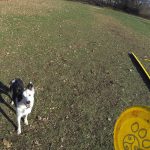 Waiting on cue and situationally is extremely important for disc dog freestyle training. The competition field might not see too much waiting going on as everything is supposed to be happening in flow,... More between each trick just remove the Wait cues and go live speed.
Waiting on cue and situationally is extremely important for disc dog freestyle training. The competition field might not see too much waiting going on as everything is supposed to be happening in flow,... More between each trick just remove the Wait cues and go live speed.
So let’s recap:
- Clear and Attainable Criteria
- Ease into it
- Trick…wait… Trick
- Go Live after Five




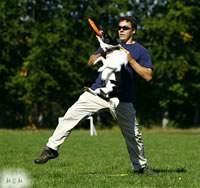

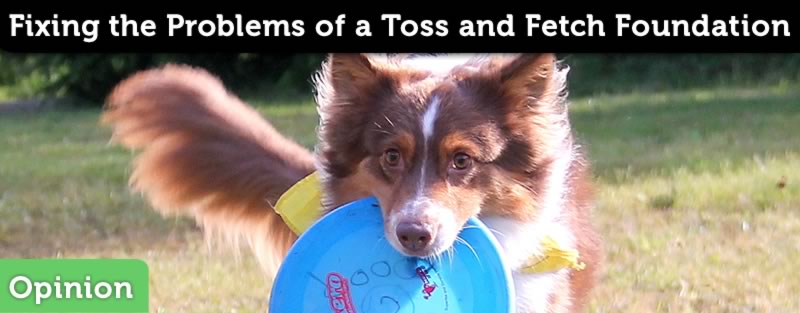


Lets work on a hypothesis.
You and your dog are on the field and you have mastered your set ups, flips vaults cotrolling the dog on the field with crosses hook ups etc. You are then man! My question is: Do you improvise or use sequences you ‘ve worked on before. So for example you set the flank dog comes towards you after the catch do you go like mmmmm a through – twist – flip would be cool to do or have you worked on that sequence before and it is a fixed one. I mean if the dog is a master of flips spins etc troughs wouldnt it be able to perform these randomly as you ask them? From what I understood by reading the article you are suggesting we work on sequences. So the more of these sequences you can master the more arsenal you got. It looks to me that these sequences are one complete trick made of little parts. If yes do you think you can name each particular sequence. So the through – twist – flip becomes a “Johny” and when you can call out a “Johy” the dog knows through – twist – flip? I hope I am clear and make sense?
So ideally when you play with the dog on the field in the end you have masterd flatwork and then use sequences (fixed ones) made of 2,3 or more parts . I am trying to see what we are striving for?
Here’s a pic that shows a few sample sequences that Apryl created from her notecards.

You can see that each sequence is made up of tricks, “little parts” , and some little parts combinations do become tricks of their own. Flip to Vault for instance, or through and flip. You can cue tricks and you can cue sequences. So, yes, Apryl could give “New Sequence 1” a cue, use it, and in theory the dog would know that it was that entire “New Sequence 1” that would follow.
I hope that makes sense.
I have 8 sequences that are set with Si:

So you can see that a routine can and probably should have a plan. I’ve played a lot of “Plan B”, make it up on the fly, by the seat of my pants routines. They are no fun. Sometimes they can be magical, but they are not consistent. Just my experience, you may very well be someone who plays better on the fly, with no plan… but what about your dog?
That said, I think that playing around like that, practicing some “Plan B” stuff, just messing around and creating things is super important as well. Especially a young player. It is very important as well to know when something is cool and stop everything and make that cool thing happen a few more times. That’s hard as a new player to give yourself that freedom to explore the game.
I would recommend the USDDN rules for a nuts and bolts breakdown of what skills you are being judged on and what they believe to be a complete disc dog routine – something that all of us should strive for. It’s a great point of reference and a pretty holistic framework. Some I think is important, some not so much, and some is downright silly, but the team element section of the rules is really pretty informative.
Watch Youtube Videos and look for what you think is cool. And then do that. You’ll have the foundation. 🙂
Great question, BTW…
Ron to elaborate on my last question “I am trying to see what we are striving for?” What should a complete disc dogger have in your opinion? If you can break it down to see how these 6 weeks would ideally lead to that it would be really helpful.
Thanks
Don’t know if this is best place but our first sequence follows:
http://www.youtube.com/user/discdogsnewmexico?feature=mhsn#p/a/u/0/tA-ygBoseUw
Consist of Figure 8, dgo around front, zig-zag, R PVR, front cross, over knee.
Interestingly, Scout forgot how to do the PVR or I didn’t cue it more likely.
This was probably the best zig zag he’s done
Just wanted to make sure you were cool with our Skype discussion on this, Bob…
Yes, ron, i do think we need some good slow mo video on front, i get rear cross that explaination was great.